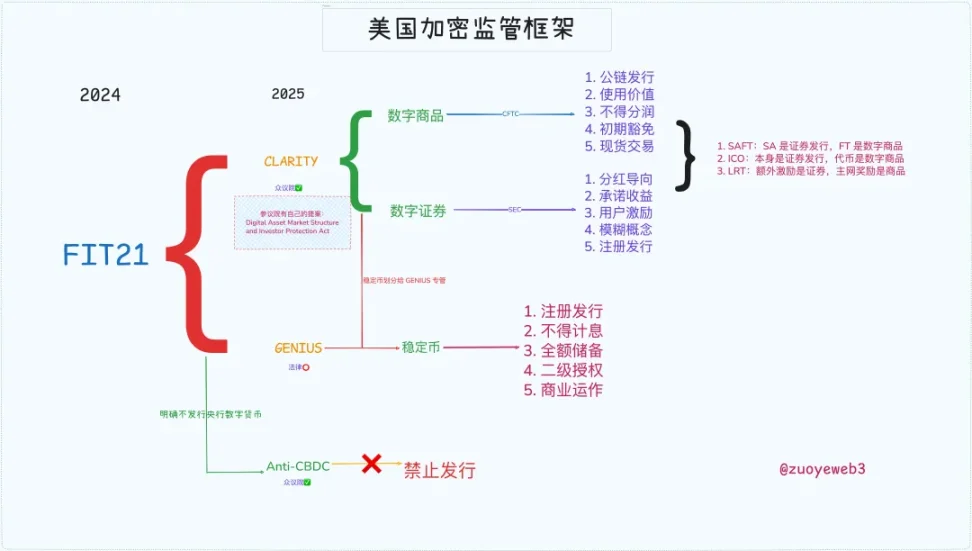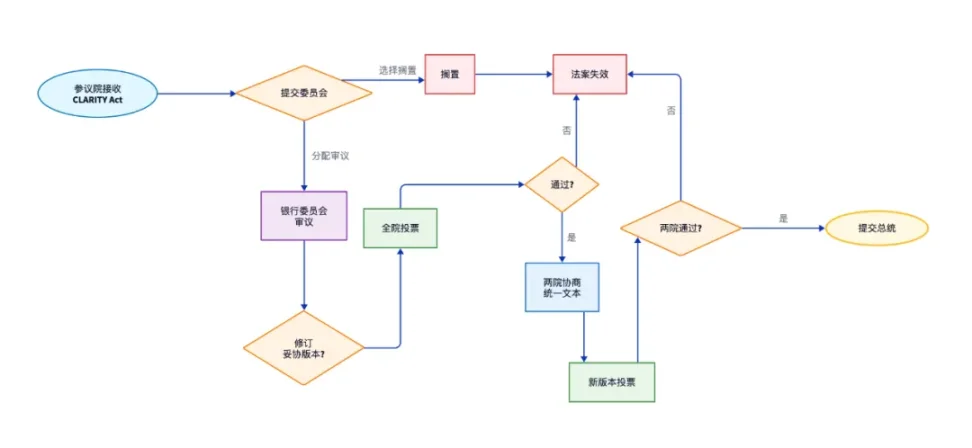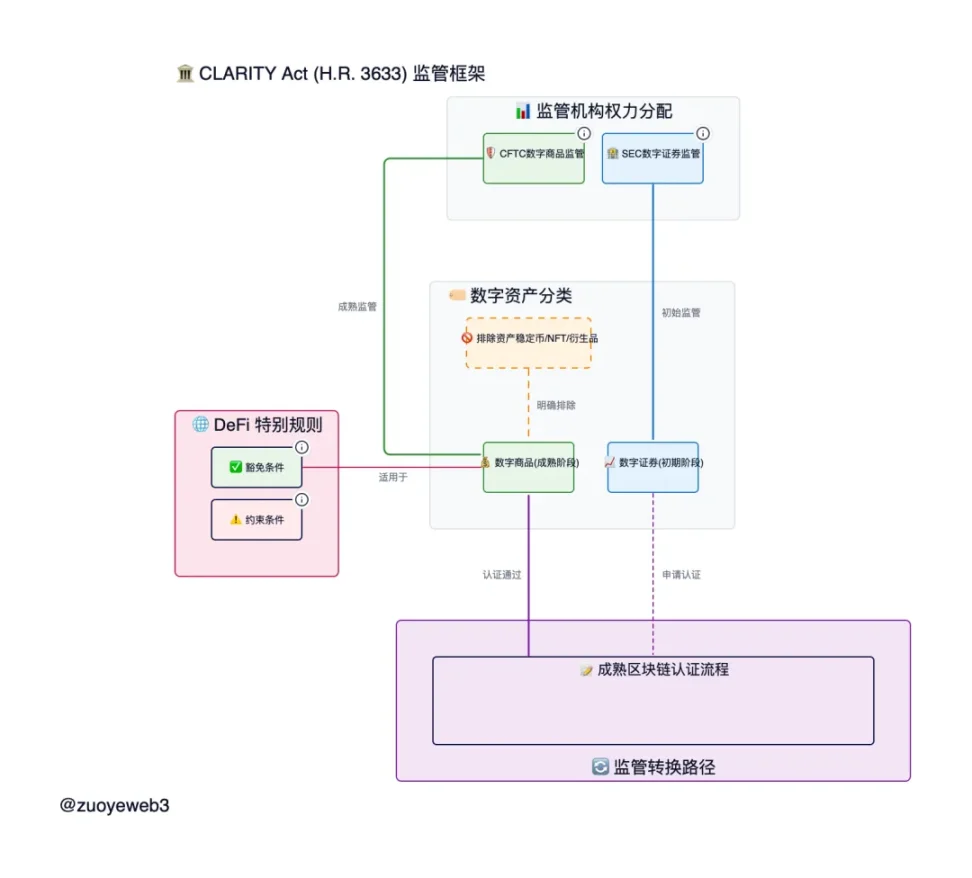Author: Zuo Ye
Crypto Week triad, the Genius Act specifically regulates stablecoins, which has become law, while the anti-CBDC Act and the CLARITY Act are still in the legislative process.
Unlike the Genius Act, CLARITY focuses on the foundational definitions and authority allocations of crypto, especially regarding public chains, DeFi, token issuance, and the powers and responsibilities of the SEC and CFTC, closely linking with the FIT21 Act in 2024.

Image description: U.S. crypto regulatory framework, image source: @zuoyeweb3
Based on this, the U.S. has constructed a complete regulatory framework extracted from past practices; understanding history is essential for clarifying the future.
Financial liberalization, the Wild New West
Coinage rights and inflation; the Fed adheres to the former under the pretext of controlling the latter, while Trump abandoned the latter under the guise of amplifying the former.
The Genius Act has opened the era of free stablecoins, and the independent coinage authority insisted by Powell has been decentralized, returning to the new elites of Silicon Valley and the old money of Wall Street. However, it's still not enough; what Peter Thiel wants is the absolute freedom of libertarians.
In 2008, the financial crisis made financial derivatives a target of criticism, and Obama urgently needed professionals to help him constrain the $35 trillion futures contract market and the $400 trillion swap market.
Thus, Gary Gensler was nominated as CFTC Chairman, and in 2010, the Dodd-Frank Wall Street Reform and Consumer Protection Act was enacted, bringing the derivatives market into the existing regulatory framework.
Gary claims, 'We must tame the Wild West,' marking the first time Gary has triumphed over the market from a regulatory standpoint.
History is cyclical; in 2021, Obama's ally, then-President Biden, nominated Gary Gensler again as SEC Chairman, attempting to cycle through the new frontier—cryptocurrency.
There are two focal points:
1. There is no dispute that the SEC considers BTC/ETH as goods, but for other tokens and IXOs, they all consider them illegal securities issuance, including SOL and Ripple.
2. Regarding the high leverage behavior of exchanges, Gary believes this is 'inducing' users, initiating special regulatory actions against onshore and offshore entities like Coinbase and Binance.
However, despite the meticulous planning, Gary ultimately bent to the ETF, which seemed not to be a regulatory focus. In 2021, the SEC approved the Bitcoin futures ETF but has remained tight-lipped about the spot ETFs proposed by Grayscale and others.
But sadly or not, after the SEC's defeat regarding Ripple's IXO part in 2024, the SEC finally approved the Bitcoin spot ETF, allowing MicroStrategy to openly engage in the crypto-stock-bond cycle.
This time, cryptocurrency represents the wilder side, conquering the SEC, CFTC, the White House, Congress, the Federal Reserve, and Wall Street, ushering in an era of unguarded openness.
A small footnote: SBF successfully sent himself to prison in 2022 by donating tens of millions in campaign funds to Biden, which may be an important reason prompting Gary's strict stance on the crypto industry.
The CLARITY Act brings proper naming to crypto.
Trump will repay kindness, and the crypto industry will henceforth be aboveboard.
In 2025, as a relic of two Democratic presidents, Trump chose to fire Gary as soon as he took office, selecting Paul Atkins, who had befriended him since 2016, to succeed him, starting a period of complete laissez-faire.
The CLARITY Act was proposed against this broader backdrop, but it must first be stated that the CLARITY Act is still in the legislative process, having completed the House process but still needing Senate review.
The Senate also has its own (Digital Asset Market Structure and Investor Protection Act), but under the Republican-led agenda framework, crypto-friendliness is inevitable.

Image description: Follow-up process of the CLARITY Act, image source: @zuoyeweb3
The current CLARITY Act is designed to frame digital goods, digital assets, and stablecoins; it first limits stablecoins to payment forms, secondly categorizes digital goods under CFTC management, and digital assets under SEC handling.

Image description: CLARITY Act regulatory framework, image source: @zuoyeweb
1. CFTC wins big: clarifying the status of ETH and CFTC, blurring the boundaries of SEC and asset issuance.
ETH is a good; truly decentralized public chain tokens are all goods, their trading falls under CFTC, while IXOs, SAFT, and other financing still belong to SEC management. However, there is a $75 million exemption threshold, and tokens issued can be exempt from penalties if they transition to decentralization within four years.
2. Digital goods, in form, are digitalized; in content, they are goods.
Keeping up with technological development, no longer crudely dividing into 'physical goods' and 'virtual assets,' acknowledging the existence of digital goods, as long as they have practical value for public chains, DeFi, and DAO protocol operations, they are no longer securities.
However! NFTs must be assets and cannot be goods, as they are each unique, only possessing 'speculative' or appreciation value and cannot serve as a uniform exchange intermediary like currency. Furthermore, interest, rewards, and profit sharing must have value that maintains the decentralized operation of the protocol; otherwise, they all fall under SEC management.

This definition is still too abstract; essentially, the CLARITY Act distinguishes between the token issuance process and the token operation process. The following three cases are the situations I have classified; please correct me if there are issues:
IXO issuance is securities, but if the issuance of tokens meets the conditions, then it is not.
Airdrop points are securities, but if the airdropped tokens meet the conditions, then they are not.
Exchange distribution is not securities, but promised returns are securities.
Meeting the conditions refers to the definition and basis of digital goods, and promising to transition into a decentralized protocol in the future without needing intermediaries for transactions. However, it should be noted that participating in a project itself is a form of investment; if there is an expectation of profit, it is considered participation in asset issuance.
How the future is defined is still unclear, but many past cases can provide a basis for differentiation:
ETH is a digital good, but utilizing SAFT for project financing is the issuance of digital assets, which falls under SEC management. However, if it later transforms into a fully decentralized protocol, it becomes a digital good, under CFTC jurisdiction.
ETH's native staking is also a good, which is a 'system behavior' that maintains the PoS characteristics of public chains. However, whether tokens issued by third-party DeFi staking protocols can be considered goods is uncertain; for example, Lido is debatable, while EigenLayer might lean more towards goods, needing clear regulatory details.
Ethereum is a blockchain, but many L1/L2 issued by SAFT or IXO have four years to achieve decentralization, with a single centralized control of tokens or voting proportions not exceeding 20%. Current foundations or DAOs may not be exempt, requiring analysis of holding proportions.
The CLARITY Act is indeed very detailed, setting up a framework for joint regulation by the SEC and CFTC, balancing the different characteristics of digital goods that also pertain to virtual securities and physical goods, which indeed require a joint approach.
Conclusion
The CLARITY Act is an important part of U.S. crypto regulation, fundamentally defining core issues such as tokens and public chains, clarifying the definition of digital goods, leaving the rest to be assets, such as NFTs, stablecoins, and tokenized assets (RWA).
However, the operation of DeFi remains in a gray area. Although the CLARITY Act has amended the definitions of (securities law), DeFi is too important; just like the securities law, the crypto market also needs a dedicated DeFi Act, rather than being lumped together with stablecoins, public chains, and tokens.
This is not an inch-by-inch advance; it is part of the construction of the U.S. crypto regulatory framework. The Tornado Cash case is still ongoing, and the fate of co-founder Roman Storm will become a touchstone for judicially compelling legislation.



